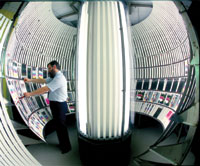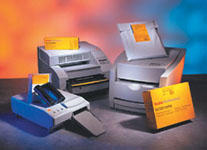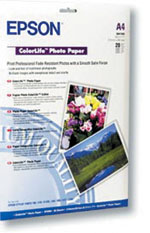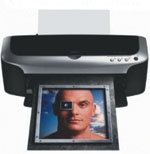 |
|
|||||||
|
Features
Going,
Going, Gone! New ink and paper formulations and combinations churned out by Epson, HP, and Canon have increased inkjet photo longevity considerably; no longer do „fugitiveš inks make a quick escape with your precious images. In fact, some inkjet prints may now last longer than their conventional silver halide counterparts, even when subjected to less-than-perfect conditions. Labs that do accelerated lightfastness tests, such as Wilhelm Imaging Research (www.wilhelm-research.com) and the Image Permanence Institute (IPI) at the Rochester Institute of Technology (www.rit.edu/~661www1) have been humming as inkjet manufacturers and third party suppliers line up to have the fade rate of their latest ink and paper offerings tested and validated. But are these results really accurate predictors of longevity? For example, let‚s say a testing lab exposes an ink and paper combination to ten times the light it would normally receive when displayed for 12 months in an average home. If it‚s still looking good in the lab after a year does that mean it won‚t fade for at least ten years when you hang it on your living room wall? Unfortunately, there‚s no way to tell for sure unless you can wait around for a decade. Dr. Douglas Bugner, a distinguished photomaterials research scientist who heads a Kodak R&D testing facility, says some inks and papers react quite differently to relatively short testing periods under strong light than they do under longer, real-world, weaker light conditionsŲ a phenomenon called reciprocity failure. He explains: „Prints made with some ink and paper combinations will fade faster under the lower light conditions in your home than are predicted by using only high-intensity, highly accelerated, laboratory tests.š Bugner says to avoid falling into that trap, Kodak also tests under lower-intensity conditions.
But that doesn‚t necessarily follow. Heat, humidity, and other airborne contaminants such as ozone also affect longevity. Hitherto they weren‚t considered critical because inkjet photos had such poor lightfastness these additional environmental factors were often overlooked or ignored. This new nemesis is called „dark fadeš and it‚s insidious. That‚s why most inkjet manufacturers now caution that prints should be placed behind glass or sprayed or laminated to improve darkfastness. Otherwise, all bets are off on their published longevity ratings which, incidentally, they don‚t guarantee even if you follow their advice because they are only predictions and not verifiable (at least not yet). Bugner points out that Kodak not only tests papers for lightfastness, but also for other known damaging environmental factors in order to come up with a more balanced result. „On a particular ink/paper combinationš he says, „we might predict 40 years for light fade, 80 years for humidity keep, 5 years for thermal keep, and 6 months for ozone fade, with a őweakest link‚ print-life estimate of only 6 months due to ozone.š Bugner recalls that in 2002 Wilhelm rated Canon‚s Photo Paper Pro Ųwhen displayed under glassŲ at 38 years but when Canon ran more all-encompassing environmental tests on the same paper/ink/printer combination not under glass, they found it lasted only a few months.
The current controversy over how long your prints will last results from the lack of an industry standard for testing image permanence. Hopefully that will be resolved in the future by an ISO group that‚s working on it. In the meantime, who do you trust when Wilhelm says a particular ink/paper combination will last 26 years and Kodak says 152? Just bear in mind Wilhelm assumes photos in your home will be exposed to higher levels of light than Kodak does; if you are displaying prints under unusually bright conditions his predictions might be closer. On the other hand, Wilhelm‚s latest display permanence ratings that include five, dye-based 4x6-inch paper/ink combinations (based on prints being framed under glass), note various environmental factors that can affect print longevity. It is not clear, though, if tests for destructive levels of heat, humidity, and ozone have been conducted and, if so, what the results are and if they are reflected in the longevity ratings. If not, prints may begin to fade much more rapidly than the ratings indicate, especially since 4x6-inch photos are rarely displayed under glass in a typical home environment. (You can find Wilhelm‚s ratings at http://tinyurl.com/4y5rh)
With that in mind, it‚s important to think about how your prints will be viewed. Will they be taped to the fridge or framed under glass? Stored in albums or hung on a wall? It‚s now known that prints exposed to sunlight through a window or bare fluorescents will fade faster than those viewed under incandescent light; it gets even more complicated when there‚s a mixture. For optimal image life, inkjet prints should be kept out of direct sunlight and some experts even advise framing them behind ultra-violet-filtering glass. But that, too, has a caveat. Wilhelm has warned that with some inks, UV filtration might affect one dye more than another, causing a color shift before the print would ordinarily fade. While great strides have been made in the formulation of longer-lasting, dye-based inks, new ways have also been found to deliver inherently-thicker, pigment-based inks through an inkjet‚s tiny nozzles. The Old Masters mixed their colors from pigments and their paintings have hung around for centuries without excessive fading. If you really want your prints to live to a ripe old age, pigment-based inks are the way to go, because though papers play a big role in determining the longevity of dyes, they‚re not as critically important with pigments. But beware. Kodak is currently running tests that indicate using pigmented inks on porous papers may not be such a good idea. Images made with this combination may be ruined by heat-induced yellowing at temperatures as low as 23OC (73OF) even when framed behind glassŲ and well before they‚re faded by light or ozone. Al Francekevich, Digital Camera‚s imaging editor, is an advertising and fine arts photographer who, like thousands of other professionals, uses an Epson 2200 printer. It sprays pigment-based inks and outputs archival images that Epson Ųwhose testing is done by WilhelmŲ says will last between 50 and 90 years, depending on the type of paper used. „The color of pigment inks is slightly less vibrant than dye inks,š says Al, „but it‚s minor. The prints look as good as any traditional color prints I‚m used to.š Some pigment-based inks have quirks, though. They tend to change color values under different lighting conditionsŲ a condition known as metamerism. While the inks used with the 2200 minimize this problem, Al still fine tunes his prints to look best in tungsten-colored light since galleries and homes usually display art with warmer incandescent illumination. „All photographs and paintings change color in different light,š he says. It has been said that using the printer manufacturer‚s papers will give you longer-lasting images. Since manufacturers have the secret formulas for their inks it would seem they can match them to their papers for the best results. However, unlike most third-party inks that usually make no claim to longevity or color fidelity and which generally should be avoided (unless used for specialized printing such as black and white), third-party paper companies like Red River Paper, InkJet Art, and others, give you a wider choice of paper surfaces and their longevity has usually been tested at independent labs with manufacturers‚ original inksets. By all means, give them a try; Finally, here‚s a tip you can use to try to double the life of any print. Make an extra copy and tuck it behind the one you‚ve framed, with a piece of acid-free paper between them. If it has good resistance to heat and humidity, it‚ll wait there patiently in the dark, virtually sealed from the light and atmosphere until one day, like Sleeping Beauty, it will be awakened to take the place of its sibling who has faded away. The quest for archival inkjet photo quality continuesŲ with inks and papers becoming more stable as technology finds new ways to extend their life spans. But there‚s a down side, too. With prints that may last a hundred years or more, just think how many bad images will be hanging around into the next century and beyond! SHATTERING
THE GLASS IMPERATIVE Ultima does not have to be framed under glass, sprayed or laminated. Stick it to the fridge, leave it on a coffee table, push-pin it to a bulletin board, or hang it, stark naked, on the wall. Best of all, it‚ll work with almost every photo-capable printer made including Epson, HP, Canon, and Lexmark (over 180 models in all) and produce quality prints. Kodak has specific settings for your inkjet to assure perfect results or you can download Kodak‚s free Easy Share software that‚ll automatically choose the proper driver setting for your printer model to make it even easier. You can find out more about Kodak‚s ColorLast Technology at http://tinyurl.com/234g2 MEASURING
LUX WITH YOUR DIGICAM Lux = 70 x fnumber2/ (exposure time in seconds x ISO film speed). 1. Tape a sheet of matte white paper to the wall where your print is displayed. 2. Get in close (or zoom in) with your camera so the paper fills the frame (don‚t let your shadow fall on the paper). 3. Make a note of the ISO you‚ve set. 4. Next, get an exposure reading; let‚s say it‚s 1/4 second at f-8. (On some cameras you may have to take an actual picture and then press Info or check the exif data in your imaging program to see what the actual exposure was.) 5. Now multiply 70 x 8 (squared). So that‚s 50 x 64 which equals 4,480. 6. Next multiply 1/4 x 100 (you divide 100 by 4) which comes out to 25. 7. Finally divide 4,480 by 25 and you get 179 lux. If you want to go further, you can take a reading every hour and then add them up and divide by 24 for the average lux level for a day. If it‚s night time and the lights are off, just put down a zero for those hours. To get a 12-hour average, double your results. -Arthur
H. Bleich (arthur@dpcorner.com) is a photographer, writer, and educator
who lives in Miami. He does assignments for major publications both
in the U.S. and abroad, and conducts digital photography workshop
cruises. Visit his Digital PhotoCorner at www.dpcorner.com. |
|||||||
|
|
|||||||
|
©
2004 D.C. Publications, Inc. All Rights Reserved. |
|||||||


 The
inkjet printer, once scorned as a cheap substitute for the mighty
laser now prints art instead of two-bit letters and four-color pie
charts. There‚s even a new acronym, DFA, that categorizes inkjets
capable of outputting Digital Fine Arts prints that should last
a lifetime.
The
inkjet printer, once scorned as a cheap substitute for the mighty
laser now prints art instead of two-bit letters and four-color pie
charts. There‚s even a new acronym, DFA, that categorizes inkjets
capable of outputting Digital Fine Arts prints that should last
a lifetime.  Kodak
assumes photos displayed in your home will receive an average of
120 lux (a measure of light intensity) for 12 hours a day. They
blast test images with both 80,000 and 5,400 lux until they begin
to fade and then make an educated guess as to how long the print
will last under real-life conditions. Henry Wilhelm, an image permanence
expert who runs his own lab, assumes pictures will receive a higher
average of 450 lux for 12 hours a day and makes his predictions
based on test photos being exposed to 35,000 lux. Here‚s where it
gets sticky. Wilhelm maintains if his lab used Kodak‚s 120 lux assumptions,
an inkjet print he rates for 73 years of lightfastness would last
even longer, about 270 years.
Kodak
assumes photos displayed in your home will receive an average of
120 lux (a measure of light intensity) for 12 hours a day. They
blast test images with both 80,000 and 5,400 lux until they begin
to fade and then make an educated guess as to how long the print
will last under real-life conditions. Henry Wilhelm, an image permanence
expert who runs his own lab, assumes pictures will receive a higher
average of 450 lux for 12 hours a day and makes his predictions
based on test photos being exposed to 35,000 lux. Here‚s where it
gets sticky. Wilhelm maintains if his lab used Kodak‚s 120 lux assumptions,
an inkjet print he rates for 73 years of lightfastness would last
even longer, about 270 years.  Currently
about 20 companies publish paper longevity results based on the
assumption that prints will be displayed in conditions averaging
450 lux for 12 hours a day. Only Kodak and Agfa use a lower light
assumption of 12 hours at a 120 lux average. Though this has drawn
some competitive ire, Bugner says Kodak has solid research to back
up its claims. „Assumptions of 450 lux are arbitrary and way too
high,š he says. „Kodak has made hundreds of thousands of measurements
in consumers‚ homes throughout the world over the past 25 years
and light levels as high as 450 lux occur less than 2% of the time.š
He says typical home conditions during a 12-hour period average
out to 120 lux, 23O C (73O F), 50% relative humidity, and 0.01 ppm
of ozone. (You can find Kodak‚s latest study at http://tinyurl.com/6ub7g)
Currently
about 20 companies publish paper longevity results based on the
assumption that prints will be displayed in conditions averaging
450 lux for 12 hours a day. Only Kodak and Agfa use a lower light
assumption of 12 hours at a 120 lux average. Though this has drawn
some competitive ire, Bugner says Kodak has solid research to back
up its claims. „Assumptions of 450 lux are arbitrary and way too
high,š he says. „Kodak has made hundreds of thousands of measurements
in consumers‚ homes throughout the world over the past 25 years
and light levels as high as 450 lux occur less than 2% of the time.š
He says typical home conditions during a 12-hour period average
out to 120 lux, 23O C (73O F), 50% relative humidity, and 0.01 ppm
of ozone. (You can find Kodak‚s latest study at http://tinyurl.com/6ub7g)
 Paper
coatings can also significantly affect the rate of „dark fade.š
Two main types of inkjet paper are used todayŲ swellable and porous.
Swellable coatings allow inks to migrate into an ozone-resistant
polymer coating but take longer to dry. Porous coatings offer „instantš
drying Ųinks get absorbed into the surface and are held thereŲ but
they never completely seal. Therefore they‚re more vulnerable to
airborne contaminants than their swellable cousins. „It‚s well known
in the trade,š cautions Bugner, „that just about any combination
of dye-based ink on porous media will fail in less than a year due
to ozone if displayed unprotected.š
Paper
coatings can also significantly affect the rate of „dark fade.š
Two main types of inkjet paper are used todayŲ swellable and porous.
Swellable coatings allow inks to migrate into an ozone-resistant
polymer coating but take longer to dry. Porous coatings offer „instantš
drying Ųinks get absorbed into the surface and are held thereŲ but
they never completely seal. Therefore they‚re more vulnerable to
airborne contaminants than their swellable cousins. „It‚s well known
in the trade,š cautions Bugner, „that just about any combination
of dye-based ink on porous media will fail in less than a year due
to ozone if displayed unprotected.š